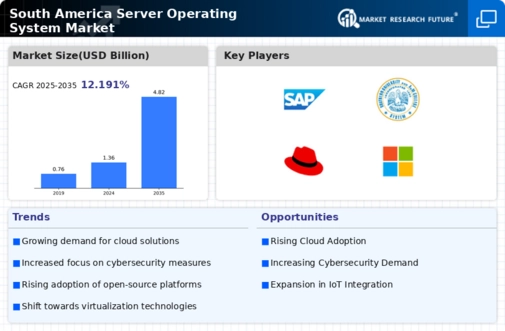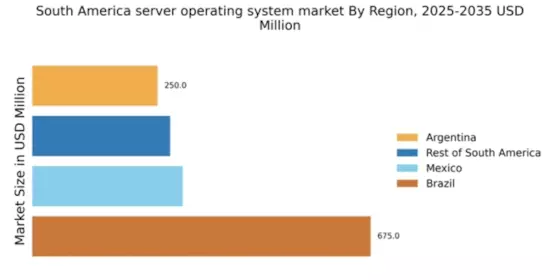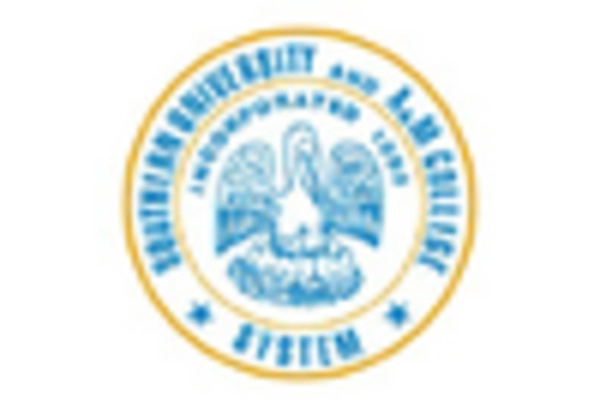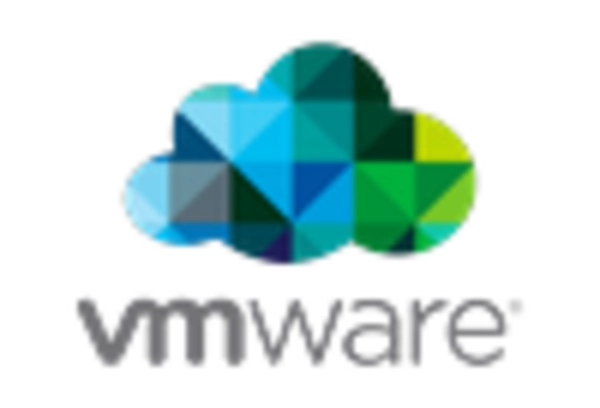Rising Demand for Cloud Services
The server operating-system market in South America experiences a notable surge in demand for cloud services. As businesses increasingly migrate to cloud-based solutions, the need for robust server operating systems becomes paramount. In 2025, the cloud computing sector in South America is projected to grow by approximately 25%, driving the adoption of server operating systems that can efficiently manage cloud environments. This trend indicates a shift towards virtualization and containerization, necessitating operating systems that support these technologies. Furthermore, organizations are seeking scalable and flexible solutions to accommodate fluctuating workloads, which further emphasizes the importance of advanced server operating systems. The integration of cloud services with server operating systems is likely to enhance operational efficiency and reduce costs, making it a critical driver in the region's market landscape.
Emergence of Hybrid IT Environments
The server operating-system market in South America is increasingly shaped by the emergence of hybrid IT environments. Organizations are adopting a mix of on-premises and cloud solutions to optimize their IT strategies. This trend necessitates server operating systems that can seamlessly integrate with both environments, providing flexibility and efficiency. In 2025, it is anticipated that over 40% of enterprises in South America will operate in hybrid IT setups, driving the demand for compatible server operating systems. These systems must support diverse workloads and facilitate smooth data transfer between on-premises and cloud infrastructures. As businesses seek to leverage the benefits of both models, the ability of server operating systems to adapt to hybrid environments becomes a crucial factor in their selection.
Growth of E-commerce and Digital Services
The server operating-system market in South America is propelled by the rapid growth of e-commerce and digital services. As online shopping and digital transactions become increasingly prevalent, businesses require reliable server operating systems to support their operations. In 2025, e-commerce sales in South America are projected to reach $100 billion, necessitating robust IT infrastructure. This growth drives the demand for server operating systems that can handle high traffic volumes, ensure uptime, and provide seamless user experiences. Additionally, the rise of digital services, including streaming and online education, further amplifies the need for efficient server management. Organizations are likely to invest in advanced server operating systems that can optimize performance and scalability, making this a vital driver in the market.
Increased Focus on Data Privacy Regulations
The server operating-system market in South America is significantly influenced by the heightened focus on data privacy regulations. With the implementation of laws such as the General Data Protection Regulation (GDPR) and local data protection frameworks, organizations are compelled to adopt server operating systems that ensure compliance. This regulatory environment creates a demand for operating systems equipped with advanced security features and data management capabilities. In 2025, it is estimated that compliance-related investments in IT infrastructure will account for over 15% of total IT spending in the region. Consequently, server operating systems that facilitate secure data handling and storage are becoming essential for businesses aiming to avoid hefty fines and reputational damage. This driver underscores the necessity for operating systems that not only support operational needs but also align with evolving legal requirements.
Technological Advancements in Server Hardware
The server operating-system market in South America is significantly impacted by technological advancements in server hardware. Innovations in processing power, memory, and storage capabilities are driving the need for operating systems that can fully utilize these enhancements. In 2025, the market for server hardware is expected to grow by 20%, leading to increased demand for compatible server operating systems. These advancements enable organizations to improve performance, reduce latency, and enhance overall system efficiency. As businesses invest in cutting-edge hardware, the server operating systems must evolve to support new features and functionalities. This driver highlights the importance of aligning operating systems with the latest hardware developments to ensure optimal performance and competitiveness in the market.


















Leave a Comment